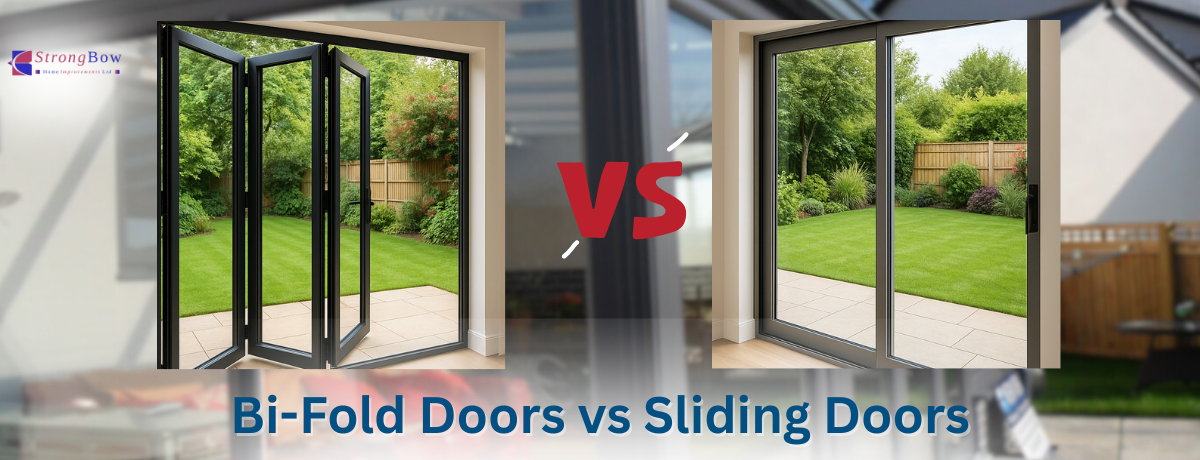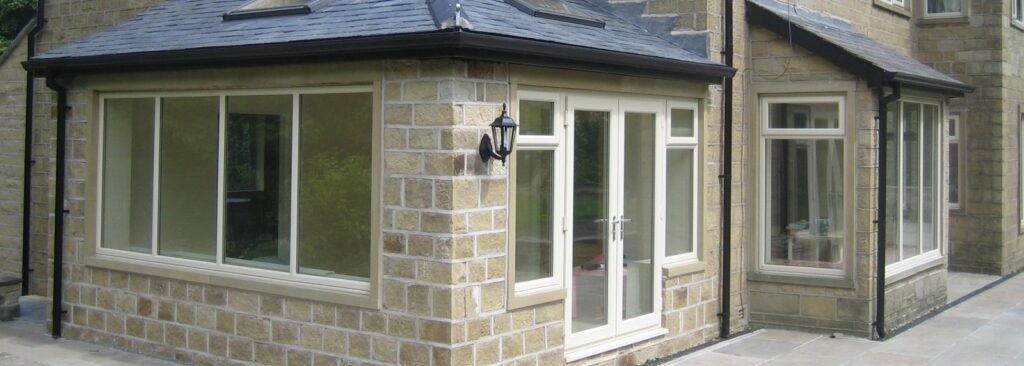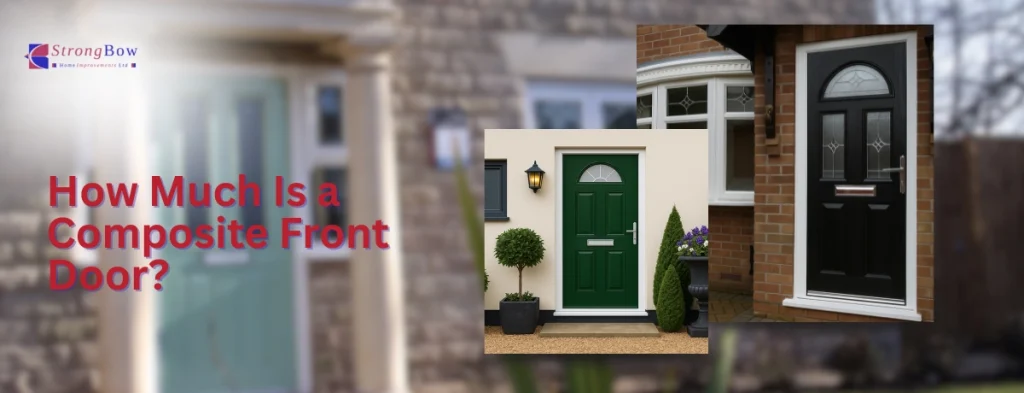Bi-folding and sliding doors are two of the most popular door choices in UK homes for reasons like better light, access, and connection between their indoor and outdoor space. Even though both the designs can transform your property well, their design and day-to-day practicality are quite different.
Choosing between bifolding or sliding doors isn’t only about looks. It also affects how much of the opening you can actually use, the kind of view you enjoy when the doors are closed, and the ease of moving between house and garden. These differences shape how the space works in daily life, from entertaining to quick walk outside.
Beyond appearance, practical details such as threshold design, recognised PAS 24 security standards, and U-values for energy performance are also certain things that will help you figure out which option will work best in your home.
In this blog, we’ll compare the two systems side by side by covering all the angles, such as space, views, thermal efficiency, cost, and installation, so you can make an informed choice with confidence.
What’s the Difference Between Bifolding and Sliding Doors?
When comparing bifold and sliding doors, understand how they open and the effect this has on your space.
- Bi-fold doors use a concertina system, where several panels fold and stack neatly to one or both sides of the opening. This allows almost the entire wall to open up, giving a seamless flow between your home and the garden.
- Sliding doors work differently. These doors move by gliding one panel behind the other. You won’t get the whole wall open like with bi-folds, but you do get big panes of glass and slim frames that keep your view wide and clear.
Here’s a quick comparison:
| Feature | Bi-Fold Doors | Sliding Doors |
| Opening Style | Panels fold and stack to the side | Glass panels slide behind each other |
| View When Closed | More frames visible | Slim frames, larger glass areas |
| View When Open | Up to 90–100% clear opening | Typically 50–66% of the opening |
| Space Needs | Requires stacking room inside/outside | No extra space needed; panels stay inline |
Put simply, bi-fold or sliding patio doors offer two different experiences: bifolds give you the “wow factor” of opening up an entire wall on summer days, while sliders provide year-round panoramic views with a cleaner, more minimal look.
Which Doors Make Better Use of Space?
One of the biggest differences between a sliding or bifold door is how much of the opening you actually get to use and what that means for everyday living.
Bi-Fold Doors
- Open up to 90–100% of the aperture, giving the widest possible access.
- Ideal for social spaces where you want to blur the line between kitchen, living area, and garden.
- Panels do need to stack at one or both sides, so you’ll lose some patio or indoor clearance. In smaller homes, this can affect furniture layout or restrict how you use the corners.
Sliding Doors
- Typically open to around 50–66% of the space, as at least one panel always stays fixed.
- Because the panels glide inline, they don’t intrude on patios, balconies, or interiors.
- A smart choice for tighter layouts, and if you want more opening, then pocket sliders (which disappear into a wall cavity) can stretch the usable space further.
The takeaway is that sliding or bi-fold doors solve the space question differently . Bi-folds maximise openness but need room to stack, while sliders save every inch of surrounding space but sacrifice part of the opening width.
How Do These Doors Affect Views and Natural Light?
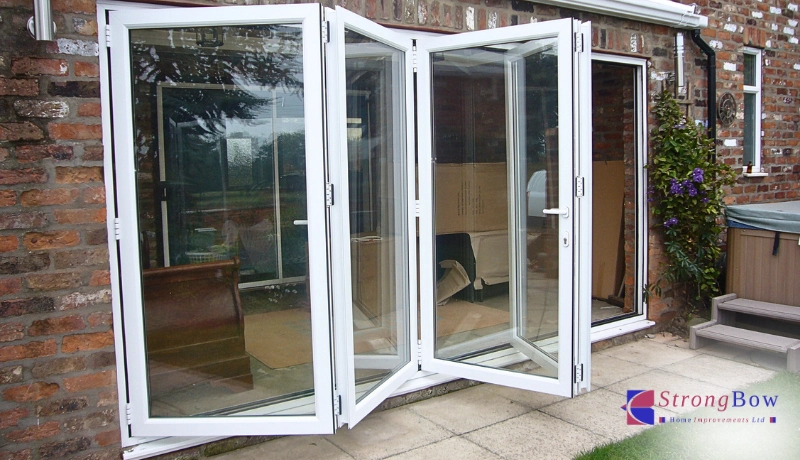
The view you get day-to-day can also be a pretty good factor when deciding between sliding and bi-folding doors.
Sliding doors give the cleanest outlook when closed. Their wide glass panels and slim frames mean fewer interruptions to your garden view and more daylight entering the room. In practical terms, this makes sliders a strong option for south-facing rooms that need light all year or homes with scenic landscapes you want to enjoy even in winter.
Bi-fold doors are different. When shut, the multiple vertical frames break up the glass more than sliders, so the view feels more segmented. But when you fold them right back, they disappear into neat stacks and leave you with a completely frame-free opening.
This creates the ultimate indoor-outdoor feel, which is ideal for entertaining in summer or making a kitchen extension feel like part of the garden.
In short, sliders win on uninterrupted views and year-round light, while bifolds deliver the wow factor of a fully open wall when the weather plays along. By now, if you have made up your mind to invest in any of these doors, visit our door and window experts website. Here, you can order the best bifold doors and sliding doors that fit your home and budget perfectly.
Sliding And Bifold Doors: Which Doors Are Easier to Use Day-to-Day?
Practical use matters just as much as looks. When it comes to everyday living, sliding and bi-folding doors each have their own strengths.
Bi-Fold Doors
- Most systems include a traffic door, i.e., a single hinged panel that works like a normal door. It’s handy for quick trips into the garden, letting the dog out, or bringing in laundry without folding the whole set.
- When fully opened, the clear threshold creates easy flow, especially if you choose a flush design that avoids trip hazards.
- For families or anyone who values quick in-and-out movement, this is a big plus.
Sliding Doors
- Known for their smooth glide, they’re effortless to move even with large panes of glass.
- You can slide them open just enough for a breeze or to step outside, but you’ll need to shift one of the bigger panels each time.
- Tracks are often slightly raised, though recessed options are available if you want a neater floor level and better accessibility.
The slimmest sliding and bifolding doors may look similar in a showroom, but day-to-day use feels different. Bifolds excel with quick access and flush thresholds, while sliders keep things simple with smooth, partial openings.
Which Doors Perform Better for Heat and Security?
Energy performance is one of the main reasons people upgrade their doors. After all, better insulation means lower heating bills and a more comfortable home. So how do sliding doors or bifold doors compare?
With larger panes of glass and fewer frame sections, sliding doors tend to have fewer weak points where heat can escape. This usually makes them slightly more efficient, especially in modern aluminium systems with thermal breaks.
Fewer seals also mean less chance of draughts over time. For many homeowners, an affordable sliding door can be an easy way to improve insulation and still enjoy wide views.
Bifolds, on the other hand, are made up of several panels; and there are more joints and seals. These can be potential spots for heat loss if not installed correctly. That said, modern bifold systems are a big step up from older designs. With quality glazing and professional fitting, they can meet and often exceed UK regulations for energy performance.
But, whichever style you choose, both doors can be specified with advanced security features:
- PAS 24 certification,
- Multi-point locking systems,
- Anti-lift tracks, and…
- Toughened or laminated glass.
The result is peace of mind that your rear entrance is as secure as it is stylish.
To sum up here, the sliders may have a slight edge for thermal efficiency, while bifolds rely more on installation quality. On security, both are equally capable when fitted with the right specifications.
Which Doors Make the Bigger Style Statement?
The kind of home you live in and the impression you want to create are two important things when you want to choose between sliding doors vs bifold doors for aesthetics.
- For modern townhouses and new-builds: A top end sliding door with slim sightlines fits pretty well with contemporary designs. Because the frames are slim, it keeps the focus on scenery outside, not on the door structure.
- Period homes or extensions: Bi-folds often make the bigger statement. Their dramatic opening transforms a kitchen-diner into a garden-facing hub, and the ability to fold left, right, split in the middle or even go cornerless makes them easier to adapt around older layouts.
- For homeowners who love personalisation: Both door types offer plenty of scope to get creative. From over 150 RAL colours to textured finishes and designer handles, you can match the frames to your windows or go bold with a contrasting shade. Either way, your doors can look as unique as the home they’re fitted in.
In short, sliding doors lean towards sleek minimalism, while bifolds deliver flexibility and drama, and both can be tailored to suit anything from a glassy new build to a classic Victorian terrace.
How Do Costs and Installations of Bi-Fold Doors and Sliding Doors Compare?
Price is one of the biggest deciding factors, but it’s not always as simple as one system being cheaper than the other. Both bi-fold vs sliding doors vary in cost depending on size, design, and installation requirements.
Sliding Doors
At standard sizes, sliding systems are competitively priced. Costs rise quickly with very large sliding doors, pocket designs that vanish into a wall, or triple-track systems, as these use heavier glass and need specialist lifting equipment on site.
Installation also takes longer because the frames must be perfectly aligned for smooth operation and airtight sealing.
Bi-Fold Doors
Bifolds are generally more affordable at small-to-medium widths, especially in standard aluminium profiles. However, slimline frames, cornerless layouts, or premium brands can cost as much as (or more than) sliders.
Installation is usually simpler because panels are lighter and easier to handle, though care is needed to adjust the many moving parts and seals correctly.
Here’s a rough UK cost comparison to give you an idea:
| Factor | Bi-Fold Doors | Sliding Doors |
| Typical supply cost (aluminium) | £1,200–£1,800 per metre | £1,500–£2,200 per metre |
| 3–4 panel average | £3,000–£4,500 | £2,800–£4,500 |
| Premium / slimline / cornerless | £6,000–£8,000+ | £6,000–£10,000+ (for very large sliding doors or pocket/triple track) |
| Installation complexity | Easier to handle (smaller panels) | Heavy glass, may need specialist lifting kit |
| Installation cost | ~£600–£1,200 | ~£900–£1,500+ |
Disclaimer: The prices above are estimates based on typical UK aluminium systems. Actual costs can vary significantly depending on size, glazing, brand, location, and installer. Always request a tailored written quote for an accurate figure.
Bifolds usually win for cost-effectiveness in modest projects, while sliders climb in price at larger spans. Installation is simpler with bifolds, but sliders demand more time and expertise to fit correctly.
Pros, Cons & How To Make the Right Choice
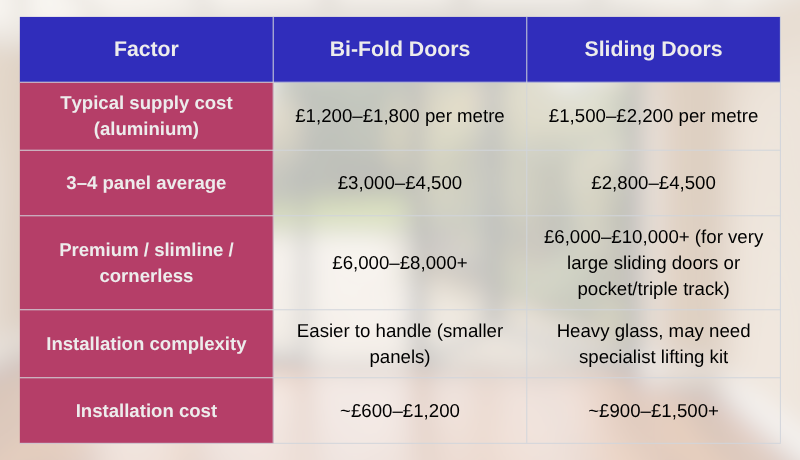
To make things simple, here’s how bi-fold and sliding doors compare at a glance:
| Feature | Bi-Fold Doors | Sliding Doors |
| Opening | Full-width, 90%+ clear | 50–66% clear |
| Views (when closed) | More frames visible | Fewer frames, panoramic glass |
| Space Use | Needs stacking room | Inline sliding, space-saving |
| Ease of Use | More steps, but traffic door helps | Smooth glide, easy partial opening |
| Thermal Efficiency | Good | Slight edge |
| Cost | Cheaper at standard sizes, but premium slimline/cornerless can cost more | Affordable in standard sizes, pricier for very large panels |
Choose Bi-Fold Doors if…
- You want the widest possible opening to host family gatherings or parties.
- Seamless indoor-outdoor living is a priority.
- You like the option of a traffic door for quick daily access.
Choose Sliding Doors if…
- You value uninterrupted views and panoramic glass year-round.
- You have limited space indoors or out.
- Energy efficiency is a top priority.
In larger homes, many people choose to mix the two: sliders on the main rear elevation for the views and bifolds on side returns or smaller extensions for flexibility.
Final Verdict: There’s no clear winner in the sliding doors or bi-fold doors debate. The right choice depends on your home’s layout, how you plan to use the space, and your budget. Both systems can be tailored with colours, finishes, and configurations, and with the best suppliers and installers nationwide, you’ll have no trouble finding a setup that fits.
If you’re ready to take the next step, contact Strongbow Home Improvements Ltd, a FENSA Registered Company that manufactures, supplies and installs both bi-fold and sliding doors across West Yorkshire. Get your free, no-obligation quote today.

